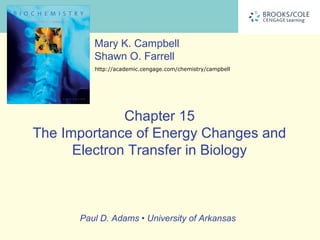
Metabolism i-chp-15-bioc-361-version-oct-2012 - Intro
- 1. Mary K. Campbell Shawn O. Farrell http://academic.cengage.com/chemistry/campbell Chapter 15 The Importance of Energy Changes and Electron Transfer in Biology Paul D. Adams • University of Arkansas
- 2. The Nature of Metabolism • Metabolism: the chemical reactions of biomolecules. It is the biochemical basis of life processes • catabolism: the breakdown of larger molecules into smaller ones; an oxidative process that releases energy • anabolism: the synthesis of larger molecules from smaller ones; a reductive process that requires energy
- 3. A Comparison of Catabolism and Anabolism • Metabolism is the sum total of the chemical reactions of biomolecules in an organism
- 4. Summary • In catabolism, large molecules are broken down to smaller products, releasing energy and transferring electrons to acceptor molecules of various sorts. The overall process is one of oxidation. • In anabolism, small molecules react to give rise to larger ones; this process requires energy and involves acceptance of electrons from a variety of donors. The overall process is one of reduction
- 5. Coenzymes used in Biologically important Redox Reactions • Conversion of ethanol to acetaldehyde is a two- electron oxidation
- 6. NAD+/NADH: An Important Coenzyme • Nicotinamide adenine dinucleotide (NAD+) is an important coenzyme • Acts as a biological oxidizing agent • The structure of NADH is comprised of a nicotinamide portion. It is involved in the reaction. It is a derivative of nicotinic acid • NAD+ is a two-electron oxidizing agent, and is reduced to NADH
- 7. The Structures and Redox States of the Nicotinamide Coenzymes
- 8. FAD/FADH2 • Flavin adenine dinucleotide (FAD) is also a biological oxidizing agent • Protons, as well as, electrons are accepted by FAD
- 9. The Structures of Riboflavin, Flavin Mono- nucleotide (FMN), and Flavin Dinucleotide (FAD)
- 10. Coupling of Production and Use of Energy • The coupling of energy-producing and energy- requiring reactions is a central theme in the metabolism of all organisms • Energy cannot be used directly, must by shuttled into easily accessible forms of chemical energy • “High Energy” bonds- bonds that require or release convenient amounts of energy, depending on the direction of the reaction • ATP is essential high energy bond-containing compound • Phosphorylation of ADP to ATP requires energy • Hydrolysis of ATP to ADP releases energy
- 11. The Phosphoric Anhydride Bonds in ATP are “High Energy” Bonds
- 12. ATP • 4 (-) charges on ATP and 3 on ADP, therefore ATP is less stable. • Why is ATP less stable, charge-wise, than ADP? • Energy must be expended to put on additional negative charge on ADP • Also, entropy loss when ADP is phosphorylated because there is a potential loss of resonance hybridization of inorganic phosphate (Pi) upon phosphorylation of ADP to ATP
- 13. Loss of a Resonance-Stabilized Phosphate Ion in Production of ATP
- 14. ATP Hydrolysis Decreases in Electrostatic Repulsion • Marked decrease in electrostatic repulsion of β-phosphate of GDP upon hydrolysis of ATP to ADP
- 15. Role of ATP as Energy Currency
- 16. Summary • Hydrolysis of ATP to ADP releases energy • In the coupling of biochemical reactions, the energy released by one reaction, such as ATP hydrolysis, provides energy for another
- 17. Coenzyme A in Activation of Metabolic Pathways • A step frequently encountered in metabolism is activation • activation: the formation of a more reactive substance • A metabolite is bonded to some other molecule and the free-energy change for breaking the new bond is negative. • Causes next reaction to be exergonic
- 18. Two Ways of Looking at Coenzyme A • Coenzyme A (CoA-SH) contains units of 2- mercaptoethylamine, pantothenic acid, and 3’,5’- mercaptoethylamine ADP
- 19. The Hydrolysis of Acetyl-CoA • The metabolically active form of a carboxylic acid is the corresponding acyl-CoA thioester, in which the thioester linkage is a high-energy bond
- 20. The Role of Electron Transfer and ATP Production in metabolism
- 21. Summary • Metabolic pathways proceed in many stages, allowing for efficient use of energy • Many coenzymes, particularly coenzyme A(CoA) play a crucial role in metabolism
